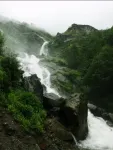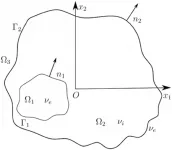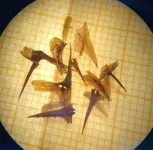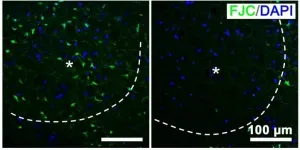Groundwater monitoring with seismic instruments
In mountain regions, water monitoring is of existential importance
2021-05-19
(Press-News.org) Water in the high-mountain regions has many faces. Frozen in the ground, it is like a cement foundation that keeps slopes stable. Glacial ice and snow supply the rivers and thus the foothills with water for drinking and agriculture during the melt season. Intense downpours with flash floods and landslides, on the other hand, pose a life-threatening risk to people in the valleys. The subsoil with its ability to store water therefore plays an existential role in mountainous regions.
But how can we determine how empty or full the soil reservoir is in areas that are difficult to access? Researchers at the German Research Centre for Geosciences (GFZ), together with colleagues from Nepal, have now demonstrated an elegant method to track groundwater dynamics in high mountains: They use seismic waves, such as those generated by ground vibrations, which they record with highly sensitive instruments. Similar to medical ultrasound, they exploit the fact that the waves propagate differently in different subsurface conditions. The researchers led by Luc Illien, Christoph Sens-Schönfelder and Christoff Andermann from GFZ report on this in the journal AGU Advances.
Seismic waves well-known from earthquakes. After a rupture in the subsurface, they propagate rapidly and unleash destructive forces. However, there are also much smaller waves caused, for example, by trucks, streetcars or - in the mountains - by falling rock. The ground is actually vibrating all the time. In geoscience, this is referred to as "seismic noise." What has to be laboriously extracted from the measured data of seismometers in earthquake detection turns out to be a valuable source of information when looking into the subsurface. This is because seismic waves propagate differently in the water-saturated zone than in the unsaturated zone, also called vadose zone.
Luc Illien, a PhD student at GFZ, and his colleagues used two Nepalese seismic stations at 1,200 and 2,300 meters above sea level. Luc Illien says: "The Nepalese Himalayas provide vital water resources to a large part of the population of South Asia. Most of this water drains through mountain groundwater reservoirs that we can poorly delineate." The study area comprised the catchment area of a small tributary to the Bothe Koshi, a border river between China and Nepal. Using several weather stations and level gauges, the team collected data, sometimes every minute, over three monsoon seasons. From this, they established a groundwater model that they could compare with the seismic records. The result: runoff to the Bothe Koshi is fed mainly from the deep aquifer. In the dry season, little water flows down the valley. In the monsoon, levels rise, but two distinct phases can be identified. First, it rains without increasing the discharge, but later a clear correlation between rainfall and river level becomes apparent. Christoff Andermann, co-author of the study, explains, "The first rainfall initially replenishes reservoirs in the soil near the surface. Once the soil is saturated with water, the deep groundwater reservoir, which is directly linked to the rivers, fills up. An increase in groundwater is then immediately reflected in rising river water levels."
The comparison with the data from seismometers showed that the saturation of the vadose zone can be well deduced from the seismic noise. "Only by merging the hydrological observations with the seismic measurements we could analyze the function of the vadose zone as a link between precipitation and groundwater reservoir," says Christoph Sens-Schönfelder. First author Luc Illien: "Understanding how the reservoir fills and drains is crucial for assessing its sustainability. From this, we can not only make predictions for runoff, but also warn of increased risk of landslides and flash floods." For example, if the soil is already saturated with water, rainfall will run off more superficially and can carry away slopes. Climate change is exacerbating the situation by contributing to changes in large-scale weather patterns and destabilizing the mountain environment. GFZ Scientific Director Niels Hovius, who contributed to the study, says: "Our work in Nepal and its results show how important it is to monitor numerous influencing factors. These include groundwater storage, changes in land use, land cover and precipitation regimes. Capturing and anticipating such changes will help us better predict the future of freshwater resources and mountain landscapes, especially as glaciers continue to melt."
INFORMATION:
Title of the study: L. Illien C. Andermann C. Sens?Schönfelder K. L. Cook K. P. Baidya L. B. Adhikari N. Hovius: Subsurface Moisture Regulates Himalayan Groundwater Storage and Discharge
Link to the study (open access): https://agupubs.onlinelibrary.wiley.com/doi/full/10.1029/2021AV000398
Scientific contact:
Luc Illien
PhD Student
lillien@gfz-potsdam.de
Dr. Christoff Andermann
christoff.andermann@gfz-potsdam.de
+49 331 288-2 88 22
Media contact:
Josef Zens
Dipl.-Geog.
Head of Public & Media Relations - Press Officer | Leiter der Presse- und Öffentlichkeitsarbeit - Pressesprecher
Tel.: +49 331 288 1040
E-Mail: josef.zens@gfz-potsdam.de
[Attachments] See images for this press release:

ELSE PRESS RELEASES FROM THIS DATE:
2021-05-19
The latest findings show that with clever science, a single fingerprint left at a crime scene could be used to determine whether someone has touched or ingested class A drugs.
In a paper published in Royal Society of Chemistry's Analyst journal, a team of researchers at the University of Surrey, in collaboration with the National Centre of Excellence in Mass Spectrometry Imaging at the National Physical Laboratory (NPL) and Ionoptika Ltd reveal how they have been able to identify the differences between the fingerprints of people who touched cocaine compared with those who have ingested the drug - even if the hands are not washed. The smart science behind the advance is the mass spectrometry imaging tools applied to the detection of cocaine ...
2021-05-19
Problems for eigenmodes of a two-layered dielectric microcavity have become widespread thanks to the research of A.I. Nosich, E.I. Smotrova, S.V. Boriskina and others since the beginning of the 21st century. The KFU team first tackled this topic in 2014; undergraduates started working under the guidance of Evgeny Karchevsky, Professor of the Department of Applied Mathematics of the Institute of Computational Mathematics and Information Technology.
In this paper, the researchers discuss a model of a 2D active microcavity with a piercing hole and the possibility of a compromise between high directionality of radiation ...
2021-05-19
The last ice age ended almost 12 000 years ago in Norway. The land rebounded slowly as the weight of the ice disappeared and the land uplift caused many bays to become narrower and form lakes.
Fish became trapped in these lakes.
Sticklebacks managed to adapt when saltwater became freshwater, and they can still be found in today's coastal lakes along the Norwegian coast.
Saltwater gradually changed to brackish water and later to freshwater. This environmental change naturally led to a total replacement of the animal and plant life.
The exception is the tiny stickleback, which successfully adapted as saltwater became freshwater and ...
2021-05-19
A reason for these findings could be due to the fact that Parkinson's patients often also have many risk factors for a severe course of Covid-19. For the first time, the cross-sectional study provides detailed nationwide data. The research team led by Professor Lars Tönges reports in the journal Movement Disorders of 4 May 2021.
Nationwide analysis of hospital data
The team headed by Lars Tönges has analysed data on Parkinson's treatment in 1,468 hospitals. The data were taken from nationwide databases in which information on the treated diseases and of treatments carried out in hospitals is publicly collected, for example by the Institute for the Hospital Remuneration System or the Federal Statistical Office.
A comparison between the period of the first ...
2021-05-19
Blocked blood vessels in the brains of stroke patients prevent oxygen-rich blood from getting to cells, causing severe damage. Plants and some microbes produce oxygen through photosynthesis. What if there was a way to make photosynthesis happen in the brains of patients? Now, researchers reporting in ACS' Nano Letters have done just that in cells and in mice, using blue-green algae and special nanoparticles, in a proof-of-concept demonstration.
Strokes result in the deaths of 5 million people worldwide every year, according to the World Health Organization. Millions more survive, but they often experience disabilities, such as difficulties with speech, swallowing or memory. The most common cause is a blood vessel blockage in the brain, and the best way to ...
2021-05-19
WASHINGTON, DC (May 19, 2021) - Human genetics and genomics contributed $265 billion to the U.S. economy in 2019 and has the potential to drive significant further growth given major new areas of application, according to a new report issued today by the American Society of Human Genetics (ASHG). The findings indicate that this research and industry sector has seen its annual impact on the U.S. economy grow five-fold in the last decade and outlined at least eight areas of expanding impact for human health and society. ASHG commissioned and funded the report and is grateful for generous additional contributions from Invitae and Regeneron. ...
2021-05-19
An international research team led by Professor Charles Gauthier from the Institut national de la recherche scientifique (INRS) has discovered a new molecule with potential to revolutionize the biosurfactant market. The team's findings have been published in Chemical Science, the Royal Society of Chemistry's flagship journal.
Surfactants are synthesized from petroleum and are the main active ingredient in most soaps, detergents, and shampoos. Biosurfactants, produced by bacteria, are safer and can replace synthetic surfactants.
Rhamnolipid molecules are some ...
2021-05-19
Pregnant women made only modest dietary changes after being diagnosed with gestational diabetes, according to a study by researchers at the National Institutes of Health. Women with gestational diabetes are generally advised to reduce their carbohydrate intake, and the women in the study did cut their daily intake of juice and added sugars. They also increased their intake of cheese and artificially sweetened beverages. However, certain groups of women did not reduce their carbohydrate intake, including women with obesity, had more than one child, were Hispanic, had a high school degree or less, or were between the ages of 35-41 years.
The study was led by Stefanie N. Hinkle, Ph.D., of the Epidemiology Branch at NIH's Eunice Kennedy Shriver ...
2021-05-19
WASHINGTON (May 19, 2021)--Early online support for the Boogaloos, one of the groups implicated in the January 2021 attack on the United States Capitol, followed the same mathematical pattern as ISIS, despite the stark ideological, geographical and cultural differences between their forms of extremism. That's the conclusion of a new study published today by researchers at the George Washington University.
"This study helps provide a better understanding of the emergence of extremist movements in the U.S. and worldwide," Neil Johnson, a professor of physics at GW, said. "By identifying hidden common patterns in what seem to be completely unrelated movements, topped with a rigorous mathematical description of how they develop, our ...
2021-05-19
DALLAS, May 19, 2021 -- Steps to ensure safety and mitigate the spread of COVID-19 have had some unintended consequences on the management of chronic conditions such as high blood pressure, a leading cause of heart disease and health disparities in the United States. COVID-19 has disproportionately affected people from different racial and ethnic groups, those who are from under-resourced populations and communities that face historic or systemic disadvantages. Discussions and research are ongoing to address what many experts label as long-existing inequities in the U.S. health system, according to information published today in the Journal of the American Heart Association, an open access journal of the American Heart Association.
"Media coverage has examined how ...
LAST 30 PRESS RELEASES:
[Press-News.org] Groundwater monitoring with seismic instruments
In mountain regions, water monitoring is of existential importance






